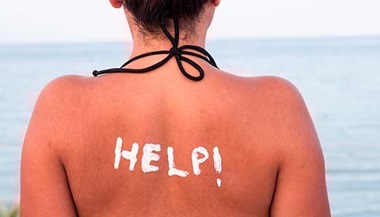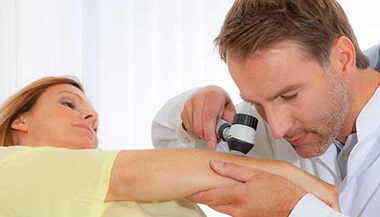Blisters
What is a blister?
A blister is a bubble containing fluid under the top layers of skin. Blisters are often shaped like a circle. The fluid that forms below the skin can be bloody or clear.
What causes blisters?
Injury, allergic reactions, immune diseases, or infections can cause blisters. These may include:
-
Burns or scalds.
-
Sunburn.
-
Rubbing (friction), such as from shoes rubbing against the skin.
-
Atopic dermatitis.
-
A contagious skin infection (impetigo) or viral infection (chickenpox, shingles).
-
Allergic reactions, such as poison ivy.
-
Autoimmune disease.
-
Don't burst (puncture) the blister unless your health care provider tells you to. Opening the blister could lead to infection.
-
Wash the area with soap and water.
-
Keep the area clean and dry.
-
Use padding around blisters that are caused by friction, such as those on your feet. Cut the padding into a donut shape and place it around the blister. This reduces pressure on the sore area.
-
If the blister bursts, place a bandage or dressing on the area to allow drainage and keep it clean.
-
Watch the area for signs of infection, such as increased warmth, swelling, redness, drainage, pus formation, or pain. If you notice any signs of infection, call your provider. You may need antibiotics.
-
If you have full-body discomfort, such as flu-like symptoms, fever, and an expanding red or purple rash that forms blisters, call your provider right away.
-
A blister is a bubble containing fluid under the top layers of skin.
-
Blisters are usually caused by injury, allergic reactions, or infections.
-
The symptoms of a blister may look like other skin conditions.
-
If you have whole-body symptoms, such as a fever and expanding rash, call your health care provider right away.
-
Blisters often heal on their own.
-
It is important to keep the area clean and dry.
-
Know the reason for your visit and what you want to happen.
-
Before your visit, write down questions you want answered.
-
Bring someone with you to help you ask questions and remember what your provider tells you.
-
At the visit, write down the name of a new diagnosis, and any new medicines, treatments, or tests. Also write down any new directions your provider gives you.
-
Know why a new medicine or treatment is prescribed, and how it will help you. Also know what the side effects are and when they should be reported.
-
Ask if your condition can be treated in other ways.
-
Know why a test or procedure is recommended and what the results could mean.
-
Know what to expect if you do not take the medicine or have the test or procedure.
-
If you have a follow-up appointment, write down the date, time, and purpose for that visit.
-
Know how you can contact your health care provider if you have questions. Ask how to contact your provider with concerns needing immediate care on weekends, holidays, and after office hours.
What are the symptoms of a blister?
Blisters caused by injury or rubbing (friction) will appear in that one area as a bubble filled with either clear or bloody liquid.
Blisters that are caused by another condition may appear in one area of your body. Or they may be all over your body. Blisters may be painful or itchy. In some cases, the blister may be caused by something that affects the whole body, such as an infection. Then you may also have whole-body symptoms, such as fever, pain, or extreme tiredness (fatigue). The symptoms of a blister may look like other skin conditions. Always see your health care provider for a diagnosis.
How are blisters diagnosed?
Health care providers can often diagnose blisters by looking at your skin.
In other cases, a skin biopsy may be done. A piece of skin next to the blister is removed and examined under a microscope at a lab.
The blister fluid or base can also be examined under the microscope. Or sent to a laboratory for a culture.
If your doctor suspects an allergic reaction, patch tests may be done to identify the allergen.
How are blisters treated?
Blisters often heal on their own without treatment. If needed, treatment will vary, depending on the cause. Talk to your health care provider about treatments that are right for you. You can follow general guidelines for first aid:
Key points about blisters
Next steps
Tips to help you get the most from a visit with your health care provider:






